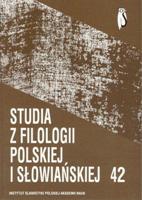Wybrane aspekty seksizmu w gwarach czarnogórskich na przykładzie ekspresywnych i wulgarnych określeń kobiet
Selected aspects of sexism in Montenegrin dialects (as exemplified by expressive and vulgar descriptions of women)
Author(s): Tomasz KwokaSubject(s): Language studies
Published by: Instytut Slawistyki Polskiej Akademii Nauk
Summary/Abstract: On the basis of a very rich lexical material covering four Montenegrin dialects (Piva, Uskoci, Zagarač, Vasojevići), the article deals with linguistic andro¬centrism, which is characterized, among others, by the unequal treatment of men and women in the language code, with a clear masculine domi¬na¬tion and an unfavorable, definitely more negative, image of women. The analyzed feminative vocabulary is characterized by richness and vividness of expressivisms, vulgar derivates and contemptuous names of women of a doubtful moral attitude, an unusual style of being or a character, a questioned intellectual level or just women of atypical anatomy. The number of words descri¬bing women is a regional phenomena which does not occur in any other parole groups of this region. A particularly lexically numerous group is the one describing women acting in a more liberated way and taking the male-female relations more freely. The article covers the presentation and the analysis of motivation behind creating female names, it indicates the word-building principles and patterns for creating the descriptions of women and lists the words and associations most commonly used to create vulgar feminatives. Serbian-Croatian vul¬garisms constitute a group of words, derivate roots for most of such derivates. These include vulgar names of sexual organs (pizda, pička, kur(ac)) or other parts of body (guz(ica), dupe), as well as verbs relating to bodily functions (jebati, prdeti, pišati i smrdeti). Feminatives are created as affixation derivates (with pejorative suffixes: -ulja, -uša, -ina, -ača), compounds, and some of them are associative derivates, metaphoric semantic transfers concerning the names of body parts.
Journal: Studia z Filologii Polskiej i Słowiańskiej
- Issue Year: 2007
- Issue No: 42
- Page Range: 143-164
- Page Count: 22
- Language: Polish

